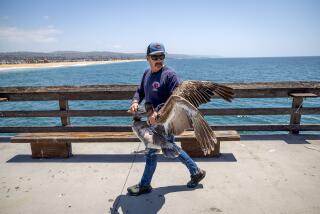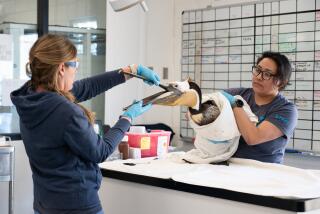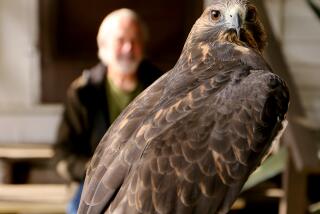Working to Make Pelicans Well Again
- Share via
Kevin Lucey spent $500 to save a seabird he had never laid eyes on, and named him Phoenix for his ability to revive.
The endangered California brown pelican had been found in November, dying on a beach. He had a cut that ran the length of his pouch, and he weighed 4 pounds -- less than half his normal weight. At the International Bird Rescue Research Center in San Pedro, Phoenix has now had two of the three surgeries he will need to survive in the wild. But Lucey has seen the bird only once, when Phoenix was unconscious during his second operation.
The center’s pelican “adoptions” aim to restore birds to health and freedom -- as untouched by humans as possible.
Sponsors pay between $200 and $500 to make this possible, even though their adoptive role is largely ceremonial. The money goes toward the birds’ care, especially the large quantities of fish they eat daily.
The center arranged 17 pelican adoptions last year and 174 in 2004. Organizers began the Adopt-a-Pelican program after a crisis in July 2004, when the need to help 200 starving young pelicans forced them to look for new sources of funding. Some of the pelicans they helped that year had ventured as far as Yuma, Ariz., in search of food they couldn’t find off the California coast.
Until recently, all donors paid $200 for their adoptions.
But last December, a month after Phoenix arrived, the center introduced a higher level of involvement for those willing to pay $500. Called Pelican Partners, they get to visit the center when their pelicans are released. They can watch as veterinarians examine the birds for the last time and mark them with leg bands for future tracking. They are even allowed to open their birds’ cages and set them free.
It was an easy sell for Lucey.
“If you take one look at those little guys, they actually get along; they mean absolutely no harm to anybody. They’re beautiful birds,” said Lucey, a resident of Orange and a chemist for a company that helps clean up chemical spills. “It seemed like an opportunity, and maybe others down the road will stand up and do the same thing to help.”
The rescue center is banking on it.
Lucey’s pelican, a brown-feathered juvenile less than 4 years old, has a green band marked “G3” above one of his webbed feet. He’s one of two pelicans and 20 other birds recovering at the nonprofit’s Southern California facility, situated on an outcropping at Ft. MacArthur in San Pedro.
The pelican adoption program is one of a variety offered at the center’s San Pedro facility and its Northern California headquarters, spokeswoman Karen Benzel said. The center was founded in Berkeley in 1971 after nearly a million gallons of crude oil spilled from tankers that had collided under the Golden Gate Bridge.
The coexistence between oil, nature and a growing urban population has kept the nonprofit center busy over the years, Benzel said.
It opened its San Pedro Center when a devastating 1990 spill off Huntington Beach soaked birds in crude oil and they needed to be washed with dish soap and nursed back to health.
The California brown pelican is a subspecies that nearly became extinct due to DDT and DDE (a metabolized form of DDT), which caused the birds’ eggshells to thin. When they were placed on the endangered species list in 1970, fewer than 300 breeding pairs remained, according to the organization. Today that number has grown to about 6,000, and one of the main breeding spots is on the Channel Islands.
The adoption program aims to personally involve people in the pelican’s comeback.
Phoenix was found on a Santa Barbara beach and driven to San Pedro, said Erin Kellogg, assistant manager of the Southern California center. The cause of his injury is unknown, Kellogg said. Unlike other pelicans that have been found intentionally mutilated, Phoenix’s severed pouch did not show signs of intentional harm.
In December, when a friend of Lucey’s saw a TV news clip about the pelican’s initial surgery, Lucey paid the $500 fee to adopt the bird.
He began receiving updates -- including that the bird could not quite eat normally but was still managing to gobble down about 200 fish a day.
As Phoenix grew stronger after the first surgery, the San Pedro staff invited Lucey to witness the second surgery on New Year’s Day.
Lucey and a friend, to whom he gave the pelican adoption as a gift, donned surgical wear to observe the operation. Because Phoenix could be anesthetized for only a limited time during the first surgery, the second operation was needed to further repair the wound, which might have come from a fishing line or wire.
“Everyone was working hard to keep the little guy warm,” Lucey said. “They had him under the covers with the heat going. Three people were working on [him] including the vet, and she was just as nice as could be. Obviously everyone in that room ... cared.”
So as not to disturb the bird, Lucey stayed at the surgery only briefly. Phoenix still needs a final operation before he can be released. It probably will happen later this month, Lucey said.
The pelican already is testing his wings in the center’s large aviary, where birds can try out flying and other movements as the experts watch their progress, Kellogg said.
Lucey, meanwhile, is excited about attending Phoenix’s release into the wild.
“I think that will be the big day for me,” he said, adding that he hopes more people will adopt birds in need.
“It’s comforting to know that people spend this kind of time to do this kind of work.”
More to Read
Sign up for Essential California
The most important California stories and recommendations in your inbox every morning.
You may occasionally receive promotional content from the Los Angeles Times.










